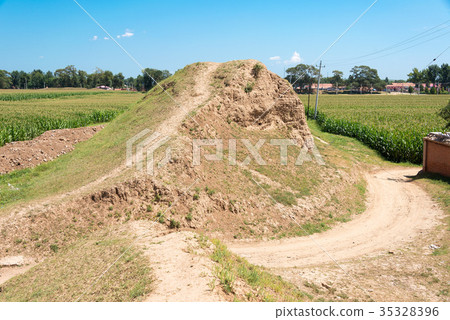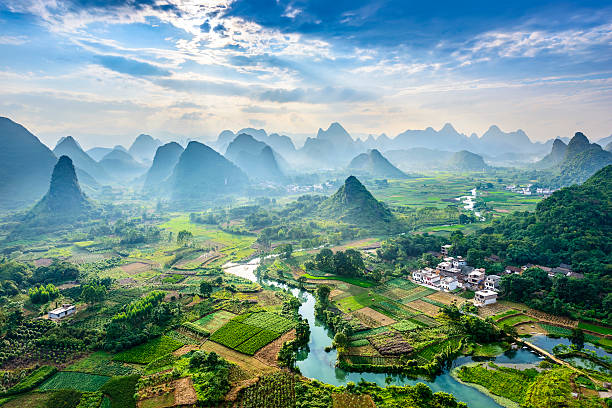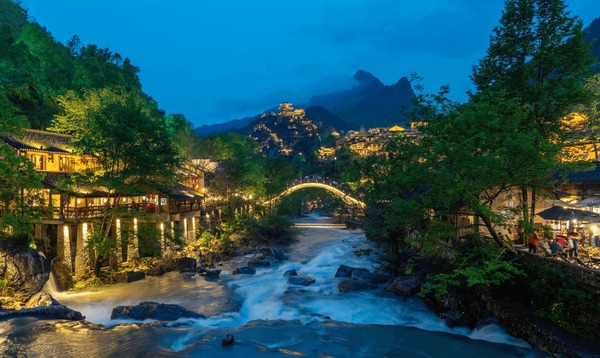Unveiling the Mysteries of Liao Zhongjing Ruins: A Journey Through History

An Essential Guide to Visiting Liao_Zhongjing_Ruins
Nestled in the heart of Inner Mongolia, the Liao Zhongjing Ruins, or 辽中京遗址, beckon the curious traveler with promises of an extraordinary journey through time. Once a bustling capital of the Liao Dynasty, this archaeological site offers a vivid tapestry of history, culture, and architectural marvels that date back to the 10th century. As you wander through the remnants of ancient structures, you will find yourself enveloped in the tales of emperors and warriors, of flourishing trade routes and vibrant society, all set against the backdrop of the vast Mongolian steppe.
The Liao Zhongjing Ruins are not just remnants of a bygone era; they are a testament to the ingenuity and resilience of the Khitan people who established one of the early multi-ethnic empires in Chinese history. Here, you can explore the remains of grand palaces, temples, and city walls, all meticulously uncovered by archaeologists. The site invites both history enthusiasts and casual travelers to engage with the past in a way that feels tangible and immediate.
Whether you are an intrepid explorer seeking to expand your knowledge of ancient civilizations or simply someone looking to escape the modern world, the Liao Zhongjing Ruins offer a serene and reflective space. Prepare to step into a world where history whispers through the stones, and every corner holds a story waiting to be discovered. As you embark on this adventure, let the echoes of history lead you through the captivating remnants of a once-great capital, where every visit unfolds a deeper understanding of the rich tapestry that is China’s legacy.
In This Guide
- An Essential Guide to Visiting Liao_Zhongjing_Ruins
- The Rich History and Legends of Liao_Zhongjing_Ruins
- Main Highlights: What You Absolutely Can’t Miss
- Planning Your Visit: A Practical Guide
- Tickets: Prices, Booking, and Tips
- How to Get There: A Complete Transportation Guide
- Local Cuisine and Accommodation Nearby
- Frequently Asked Questions
- Final Thoughts on Your Trip
The Rich History and Legends of Liao_Zhongjing_Ruins
Nestled in the heart of northeastern China, the Liao Zhongjing Ruins (辽中京遗址) serve as a captivating window into the past, revealing the intricate tapestry of history that shaped the region. Established during the Liao Dynasty (907-1125), these ruins were once the thriving capital of the Khitan Empire, known as Zhongjing, or Central Capital. The Khitan people, an ethnic group of Mongolic origin, were renowned for their unique culture and military prowess, and their establishment of Zhongjing marked a significant turning point in Chinese history.
The city of Liao Zhongjing was designed as a grand political and cultural hub, characterized by its impressive architecture and advanced urban planning. Archaeological excavations have uncovered remnants of fortified walls, palatial structures, and vibrant marketplaces, all of which testify to the prosperity and sophistication of the Khitan society. The layout of the city, with its organized streets and systematic zoning, reflects the influence of both nomadic traditions and the settled agricultural practices of neighboring Han Chinese communities.
Legends abound surrounding the Liao Zhongjing Ruins, with tales of its rulers and the celestial events that shaped their reigns. One such legend speaks of the founding emperor, Yelu Abaoji, who was said to be guided by a divine vision that led him to unify the fractured tribes of the steppe and establish a centralized governance system. His ambition was not merely to conquer but to create a harmonious society that blended the best of nomadic and agrarian lifestyles. The city became a melting pot of cultures, where Khitan customs mingled with Chinese, Tibetan, and other traditions, resulting in a rich cultural exchange that influenced art, literature, and governance.
The decline of the Liao Dynasty in the early 12th century was a tumultuous period marked by internal strife and external pressures. The rise of the Jin Dynasty, founded by the Jurchens, led to the eventual downfall of Zhongjing. The city was abandoned, its splendor fading with the passage of time, but its legacy endured. Today, the ruins stand as a testament to the resilience of the Khitan people and their contributions to the historical narrative of China.
Visitors to the Liao Zhongjing Ruins can immerse themselves in this rich history, exploring the remnants of once-grand structures and imagining the vibrant life that thrived within the city walls. The site is not only an archaeological treasure but also a profound reminder of the dynamic interplay between cultures and the enduring spirit of a people who once ruled a vast empire. As you walk through the ruins, let the echoes of the past guide your imagination, and discover the legends that continue to resonate through the ages.

Liao_Zhongjing_Ruins.
Main Highlights: What You Absolutely Can’t Miss
The Liao Zhongjing Ruins, nestled in the heart of China’s northeastern Liaoning province, offer a fascinating glimpse into the past of the Liao Dynasty (907-1125 AD). As an international traveler, here are the main highlights you absolutely can’t miss during your visit to this remarkable historical site.
1. The Grand City Walls
The remnants of the massive city walls are a testament to the architectural prowess of the Liao Dynasty. Standing tall and proud, these walls once protected the ancient capital, showcasing intricate designs and fortifications. Walking along these walls, you can imagine the bustling city life that once thrived within, making it a perfect spot for photography and contemplation.
2. The Imperial Palace Ruins
The ruins of the imperial palace are undoubtedly the crown jewel of the Liao Zhongjing site. Here, you’ll find the foundations of what was once a magnificent structure, complete with ceremonial halls and living quarters for the royal family. A visit to the palace ruins allows you to immerse yourself in the grandeur of Liao’s royal history, offering a unique perspective on the cultural and political significance of this dynasty.
3. Religious Structures
Among the ruins, you will discover remnants of ancient religious buildings, including temples dedicated to various deities. These structures highlight the spiritual life of the Liao Dynasty and its deep-rooted traditions. Take the time to explore these sites, as they provide insight into the religious practices and beliefs that shaped the lives of the people during this period.
4. The Archaeological Exhibits
The site features an array of archaeological finds that have been unearthed from the ruins, including pottery, tools, and artifacts that speak to everyday life in Liao Zhongjing. These exhibits are often accompanied by informative displays, allowing you to gain a deeper understanding of the social and economic conditions of the time.
5. Scenic Surroundings
The Liao Zhongjing Ruins are set against a backdrop of stunning natural beauty, with rolling hills and lush landscapes that enhance the historical experience. Take a leisurely stroll around the site, enjoy the serenity of the surroundings, and don’t forget to capture the picturesque scenery that frames the ruins.
6. Cultural Events and Festivals
If your visit coincides with local cultural events or festivals, seize the opportunity to participate. These events often feature traditional music, dance performances, and local cuisine that reflect the rich history and culture of the region. Engaging with the local community during these occasions can enrich your understanding of the Liao Dynasty’s legacy.
7. Guided Tours
For a more in-depth experience, consider joining a guided tour. Knowledgeable guides can provide valuable insights into the history and significance of the ruins, as well as anecdotes that you might not discover on your own. This can greatly enhance your appreciation of the site and its importance in Chinese history.
8. Photography Opportunities
With its blend of ancient architecture and stunning landscapes, the Liao Zhongjing Ruins present countless opportunities for photography. Don’t forget your camera or smartphone to capture the beauty of the ruins, the intricate details of the architecture, and the surrounding nature.
Visiting the Liao Zhongjing Ruins is not just a journey through history; it’s an opportunity to connect with a vibrant past that continues to shape the cultural identity of China today. Whether you’re a history buff, an architecture enthusiast, or simply seeking a unique travel experience, this site is sure to leave a lasting impression.

Liao_Zhongjing_Ruins.
Planning Your Visit: A Practical Guide
Visiting the Liao Zhongjing Ruins, one of China’s fascinating historical sites, offers an enriching experience steeped in ancient history and cultural significance. This guide will help you navigate your journey, ensuring you make the most of your visit.
Getting to Liao Zhongjing Ruins
Location: The Liao Zhongjing Ruins are situated in Inner Mongolia, close to the city of Chifeng. This area was once the capital of the Liao Dynasty (907-1125), making it a significant archeological site.
Transportation Options:
– By Air: The nearest major airport is Chifeng Yulong Airport. From there, you can rent a car or take a taxi to the site, which is approximately 70 kilometers away.
– By Train: Chifeng is well connected by train. High-speed trains from Beijing take about 5-6 hours. Once in Chifeng, local taxis or buses can take you to the ruins.
– By Bus: For a more local experience, consider taking a bus from nearby cities. Buses frequently run to Chifeng, and from the city, you can find transportation options to the ruins.
Best Time to Visit
The ideal time to visit the Liao Zhongjing Ruins is during the spring (April to June) and autumn (September to November) months. The weather is mild, making it comfortable for exploration. Summer can be hot, while winter temperatures can drop significantly, potentially affecting your experience.
Entry Information
Opening Hours: The ruins are typically open daily, but it’s best to check local listings for any seasonal changes in hours.
Entrance Fee: There is usually a modest entrance fee, which helps maintain the site. Keep some cash on hand, as not all places accept credit cards.
What to Expect
The Liao Zhongjing Ruins are an impressive reminder of the Liao Dynasty’s architectural prowess. The site includes remnants of ancient walls, temples, and residential areas. Here’s what you can look forward to:
- Historical Significance: Learn about the Liao Dynasty’s role in Chinese history and its interactions with neighboring cultures.
- Archaeological Finds: View artifacts discovered at the site, including pottery, tools, and other remnants of daily life from the era.
- Scenic Views: The surrounding landscape is beautiful, with rolling hills and greenery that make for excellent photography opportunities.
Tips for a Great Visit
- Wear Comfortable Shoes: The site requires a fair amount of walking, so comfortable footwear is essential.
- Stay Hydrated: Bring water, especially during the warmer months, to stay hydrated as you explore.
- Engage with Guides: If available, consider hiring a local guide. They can provide deeper insights into the history and significance of the ruins.
- Respect the Site: As with any historical location, practice respect for the ruins and follow any posted guidelines to preserve this precious heritage.
Nearby Attractions
If you have extra time, explore nearby attractions:
– Chifeng City: Discover local culture, cuisine, and additional historical sites.
– Other Ruins: The region is rich in history, so consider visiting other archaeological sites such as the remains of the Liao Dynasty palaces.
– Natural Parks: Enjoy the natural beauty of Inner Mongolia by visiting nearby parks and reserves, ideal for hiking and photography.
Conclusion
Your visit to the Liao Zhongjing Ruins promises a unique insight into China’s past, filled with rich history and stunning landscapes. With this guide in hand, you’re set for an unforgettable adventure into the heart of ancient civilization. Safe travels!

Liao_Zhongjing_Ruins.
Tickets: Prices, Booking, and Tips
Visiting the Liao Zhongjing Ruins (辽中京遗址) is an extraordinary opportunity to delve into the rich tapestry of Chinese history. To make the most of your visit, it’s essential to be informed about ticket prices, booking options, and some handy tips.
Ticket Prices
Access to the Liao Zhongjing Ruins is generally affordable, with ticket prices typically ranging from 30 to 50 Chinese Yuan (CNY) for adults. Discounts may be available for students, seniors, and groups, so it’s worth asking about any concessions when purchasing your tickets. Children under a certain age often enter for free, but it’s advisable to check the specific regulations at the site.
Booking Your Visit
While tickets can usually be purchased on-site, it’s a good idea to book in advance, especially during peak tourist seasons or holidays. You can reserve your tickets online through local tourism websites or travel platforms. Some visitors may also find it convenient to book a guided tour, which often includes transportation and insightful commentary about the ruins.
Tips for a Great Experience
-
Timing is Key: The ruins can get crowded, particularly on weekends and public holidays. For a more serene experience, aim to visit during weekday mornings.
-
Wear Comfortable Shoes: The area around the ruins may involve some walking and uneven terrain, so comfortable footwear is recommended.
-
Stay Hydrated: Bring water with you, especially if you’re visiting during the warmer months. There may be limited facilities on-site.
-
Learn Before You Go: Familiarize yourself with the historical significance of the Liao Zhongjing Ruins before your visit. Understanding the context can greatly enhance your experience.
-
Capture the Moment: Don’t forget your camera! The ruins offer stunning photo opportunities that you’ll want to remember.
-
Respect the Site: As with any historical site, be mindful of the preservation efforts. Stick to designated paths and avoid touching any artifacts.
By preparing ahead of your visit, you can fully immerse yourself in the historical and cultural significance of the Liao Zhongjing Ruins, making for a memorable adventure in one of China’s fascinating historical sites.
How to Get There: A Complete Transportation Guide
Visiting the Liao Zhongjing Ruins (辽中京遗址) offers a fascinating glimpse into the rich history of China, specifically during the Liao dynasty. To make your journey as seamless as possible, here’s a comprehensive transportation guide to help you reach this intriguing archaeological site.
Getting to the Liao Zhongjing Ruins
1. Arriving in China
International travelers can fly into major Chinese cities such as Beijing, Shenyang, or Harbin. Each of these cities has extensive international flight connections, making them convenient entry points.
- Beijing Capital International Airport (PEK): This is the busiest airport in China and offers numerous international flights.
- Shenyang Taoxian International Airport (SHE): Located closer to the ruins, Shenyang is a great option for travelers looking to minimize travel time.
- Harbin Taiping International Airport (HRB): Another alternative, particularly if you’re coming from northeast Asia.
2. Traveling to Shenyang
Once you arrive in China, your next step will be to get to Shenyang if you haven’t chosen it as your landing city.
- By Train: From Beijing, you can take a high-speed train to Shenyang, which takes about 4-5 hours. Trains depart frequently from Beijing South Railway Station.
- By Plane: Domestic flights from Beijing to Shenyang take about 1.5 hours, but considering check-in times and transportation to the airport, the train is often the more convenient option.
3. Getting from Shenyang to the Ruins
The Liao Zhongjing Ruins are located approximately 40 kilometers northeast of Shenyang. You have several options to reach the site:
- By Car: Renting a car or hiring a taxi is one of the most flexible ways to visit the ruins. The journey takes about 1 hour depending on traffic.
- Public Transportation:
- Bus: From Shenyang, you can take a local bus heading to Fushun and get off at the nearest stop to the ruins. You may need to transfer to a smaller bus or taxi depending on the bus route.
- Subway and Taxi: Take the subway to a nearby station and then a taxi to the ruins. This can be a convenient option if you’re unfamiliar with the bus system.
4. Local Transportation
Once you arrive at the Liao Zhongjing Ruins, navigating the site is relatively straightforward. You can explore on foot, as the main areas are accessible without the need for additional transportation.
- Guided Tours: For a more in-depth experience, consider joining a guided tour. Many local guides are knowledgeable about the historical significance of the ruins and can provide valuable insights.
Tips for a Smooth Journey
- Language: English may not be widely spoken, especially in rural areas. Learning a few basic Mandarin phrases or using a translation app can be helpful.
- Cash: While major cities have ATMs and accept credit cards, smaller towns may only accept cash. Ensure you have enough local currency (Renminbi) for small purchases.
- Weather: The weather can vary greatly depending on the season. Check the forecast and dress accordingly, especially if you plan to walk around the site.
With this transportation guide, you should be well-equipped to explore the historical wonders of the Liao Zhongjing Ruins. Enjoy your journey into China’s rich past!

Liao_Zhongjing_Ruins.
Local Cuisine and Accommodation Nearby
Visiting the Liao Zhongjing Ruins offers a unique glimpse into the rich tapestry of Chinese history, but the experience doesn’t have to end with the explorative journey through ancient relics. Surrounding the ruins, you’ll find a delectable array of local cuisine and comfortable accommodations, ensuring your trip is as enriching as it is enjoyable.
Savor the Local Flavors
1. Traditional Liao Cuisine
When in the vicinity of the Liao Zhongjing Ruins, indulging in local dishes is a must. The region is known for its hearty fare, which often features ingredients like lamb, millet, and various fresh vegetables. Be sure to try:
- Liao Lamb Hotpot: A warming dish perfect for sharing, this hotpot is filled with tender lamb slices and a variety of fresh greens, cooked right at your table in a savory broth.
- Millet Porridge: A staple in many meals, this creamy porridge is a wonderful way to start your day. Often served with pickled vegetables, it’s both nutritious and delicious.
- Grilled Fish: Freshwater fish from the nearby rivers make for a delightful meal; grilled to perfection and seasoned with local spices, it’s a dish you won’t want to miss.
2. Street Food Delights
For a more casual dining experience, wander through local markets where vendors serve up a variety of street food. Look out for:
- Savory Pancakes: Crispy and thin, these pancakes can be filled with a variety of ingredients, from eggs and green onions to spicy meats.
- Fried Dough Sticks: Perfect for breakfast or a snack, these light and flaky treats are often enjoyed with warm soy milk.
Comfortable Stays Nearby
After a day of culinary exploration and historical discovery, rest your head in one of the charming accommodations close to the ruins. Here are a couple of recommendations:
1. Zhongjing Heritage Inn
Nestled within a short drive from the ruins, this inn boasts a blend of traditional architecture and modern amenities. Guests can enjoy spacious rooms with stunning views of the surrounding landscape. The inn also offers local breakfast options, allowing you to start your day with a taste of the region.
2. Riverside Hotel
For those seeking a more upscale experience, the Riverside Hotel provides luxurious accommodations with an emphasis on comfort. With beautiful river views, a spa, and an on-site restaurant that serves both local and international cuisine, this hotel caters to all your needs after a day of exploration.
Conclusion
Whether you are indulging in the rich flavors of local dishes or relaxing in comfortable surroundings, your visit to the Liao Zhongjing Ruins can be complemented perfectly by the culinary and hospitality offerings nearby. Embrace the local culture, and let every meal and moment add to your unforgettable journey.

Liao_Zhongjing_Ruins.
Frequently Asked Questions
Common Questions About Visiting Liao Zhongjing Ruins
1. Where are the Liao Zhongjing Ruins located?
The Liao Zhongjing Ruins are situated in the northeastern part of China, specifically in the Inner Mongolia Autonomous Region. The site is easily accessible from the city of Hohhot, making it a convenient day trip for travelers exploring the area.
2. What is the historical significance of the Liao Zhongjing Ruins?
These ruins are remnants of the ancient city of Zhongjing, which was the capital of the Liao Dynasty (907-1125 AD). The site offers valuable insights into the culture, architecture, and urban planning of the Liao Dynasty, making it a fascinating destination for history enthusiasts.
3. Is there an entrance fee to visit the ruins?
Yes, there is a nominal entrance fee to access the Liao Zhongjing Ruins. The fee typically covers entry to the site, access to guided tours, and various informational displays. Prices may vary, so it’s advisable to check in advance or upon arrival.
4. What are the best times to visit the Liao Zhongjing Ruins?
The ideal times to visit are during spring (April to June) and autumn (September to November) when the weather is mild and the landscape is particularly beautiful. Summers can be hot, while winters may be quite cold, so plan your visit accordingly.
5. Are there guided tours available?
Yes, guided tours are available at the Liao Zhongjing Ruins. These tours provide in-depth historical context and highlight significant features of the site, enhancing your experience. It’s advisable to book in advance, especially during peak tourist seasons.
6. What should I wear when visiting the ruins?
Comfortable clothing and sturdy walking shoes are recommended, as you will be exploring an archaeological site that may require some walking over uneven terrain. Additionally, consider dressing in layers, as temperatures can vary throughout the day.
7. Are there facilities available on-site, such as restrooms or food services?
Basic facilities, including restrooms, are available at the site. However, food options may be limited, so it’s a good idea to bring snacks and water with you, especially if you plan to spend several hours exploring the ruins.
8. Can I take photos at the Liao Zhongjing Ruins?
Yes, photography is generally allowed at the site, and you’ll find plenty of stunning views and historical structures to capture. However, be respectful of any specific areas where photography might be restricted and always follow local guidelines.
Final Thoughts on Your Trip
As your journey to the Liao Zhongjing Ruins comes to a close, take a moment to reflect on the echoes of history that resonate within this ancient site. Here, amidst the remnants of a once-thriving capital, you are not just a spectator but a participant in a narrative that spans centuries. The ruins are a testament to the resilience and complexity of a culture that has withstood the tides of time, offering a unique glimpse into the social and political dynamics of a bygone era.
Walking through these storied grounds, you’ll find more than just stone and earth; you’ll discover the stories of the past—stories of triumph, conflict, and cultural evolution. This site invites you to ponder the intricate relationship between history and identity, and how the lessons of those who came before us continue to shape our world today.
As you leave, carry with you not only the memories of your visit but also the profound understanding that every stone tells a story. The Liao Zhongjing Ruins are not merely an archaeological site; they are a reminder of our shared human experience, urging us to explore, learn, and connect with the rich tapestry of history that surrounds us. Embrace the spirit of discovery that this remarkable place embodies, and let it inspire your future adventures. Safe travels!